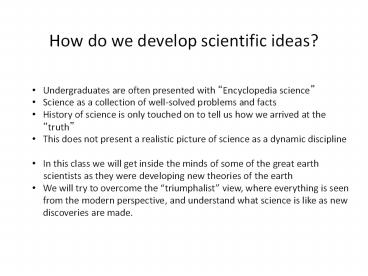How do we develop scientific ideas? - PowerPoint PPT Presentation
1 / 13
Title:
How do we develop scientific ideas?
Description:
How do we develop scientific ideas? Undergraduates are often presented with Encyclopedia science Science as a collection of well-solved problems and facts – PowerPoint PPT presentation
Number of Views:81
Avg rating:3.0/5.0
Title: How do we develop scientific ideas?
1
How do we develop scientific ideas?
- Undergraduates are often presented with
Encyclopedia science - Science as a collection of well-solved problems
and facts - History of science is only touched on to tell us
how we arrived at the truth - This does not present a realistic picture of
science as a dynamic discipline - In this class we will get inside the minds of
some of the great earth - scientists as they were developing new
theories of the earth - We will try to overcome the triumphalist view,
where everything is seen from the modern
perspective, and understand what science is like
as new discoveries are made.
2
Philosophical Issues
- Does science develop smoothly, or does it go
through long periods of stasis followed by sudden
revolutions? How do the revolutions happen? - Is there progress in science? Does progress
happen by adding to previous knowledge
(accumulation) or by replacing previous
knowledge? - Is science more than a social construct?
- To start thinking about these issues, we will
look at the development of plate tectonics, one
of the grand unifying themes in earth sciences
that has developed over the last 100 years.
3
Tectonic ideas before Continental Drift
- Not one dominant theory, but general consensus on
the fixity of the major continents. Most
geologists held to some combination of these
major ideas - Contractionist theory (Beaumont, Suess, Stille)
-- Earth is slowly contracting as it cools --
contraction produces periods of compression and
mountain building - Geosynclinal theory (Hall, Dana) -- Paired
regions of uplift and depression formed large
sedimentary basins which were later uplifted to
produce mountain ranges. - Both ideas suggested that geology was dominated
by vertical motions of uplift and subsidence,
with only limited horizontal tectonic motion.
4
Mountain building through contractionCollapsing
Earth theories
- Basic process of mountain building was thermal
contraction - Mountains resulted from wrinkling of the Earths
crust - Shrinkage of the Earths interior caused some
regions to collapse - and become ocean basins uncollapsed regions
are continents - Further shrinkage may cause uncollapsed regions
to collapse - continents and oceans trade places!
5
Successes of Contraction Theory
- Explained the presence of marine deposits on
continents - Explained the similarity of fossils on different
continents - Volcanism was attributed to the process of
continental collapse (e.g. Mediterranean Sea) - Simple thermal models predicted reduction of the
earths radius from contraction (e.g. Lord Kelvin)
6
Geosyncline Theory
From textbook The Outlines of Physical
Geology By Longwell, 1941
7
Example Appalachian Geosyncline
8
Reinterpretation of Geosynclines
Classic Appalachian Geosyncline (after Kay, 1948)
Modern Reinterpretation
From S. Dutch website
9
Early ideas of continental drift
Antonio Snider-Pellegrini (1858) "The Creation
and its Mysteries Unveiled
10
Chronology of Continental Drift Plate Tectonics
- 1912 -- First publication of Wegener's
hypothesis - 1920 -- 2nd edition of Wegener's book
widespread dissemination - 1926 -- New York symposium on continental drift
- 1930 -- Wegener's death
- 1931 -- Holmes publishes ideas about mantle
convection - 1937 -- Our Wandering Continents by Du Toit
- 1956 -- University of Tasmania symposium
(Carey) - 1956 -- paleomagnetic evidence for North America
- Europe motion (Runcorn) - 1962 -- sea floor spreading proposed (Hess,
Dietz) - 1963 -- sea floor magnetic anomalies explained
(Vine, Matthews, Morley) - 1965 -- transform faults explained (Wilson)
- 1967 -- confirmation of transform fault motion
(Sykes) - 1967 -- subduction zones proposed (Oliver and
others) - 1967 -- plate tectonics described (Morgan,
McKenzie)
11
Alfred Wegener (1880-1930)
- Alfred Wegener was a German natural scientist in
meteorology, astronomy, and geology - PhD in astronomy from U. of Berlin in 1905 but he
became interested in climatology and meteorology - His first academic position (tutor) was at the
University of Marburg in meteorology - He was fascinated by Greenland and participated
in 3 expeditions (1906, 1912, and 1930). He
died during the last one.
12
How did Wegener get the idea of continental drift?
- While at University of Marburg in 1911, Wegener
was browsing in the library when he came across a
paper that listed fossils of identical plants and
animals found on opposite sides of the Atlantic
(Brazil and Africa) - Intrigued, Wegener began to look for, and find,
more cases of similar fossils separated by
oceans. - Wegener was fascinated by the close fit between
the coastlines of South America and Africa. - Wegener decided that the similar fossils and
coastlines indicated that the continents were
once joined and subsequently moved apart to their
current positions. - He later wrote "A conviction of the fundamental
soundness of the idea took root in my mind."
13
Wegeners evidence for continental drift
- Postglacial rebound (isostacy) shows that
continents can move over a viscous substrate - Oceanic crust is fundamentally different from
continental crust, as demonstrated by the bimodal
distribution of elevation - Geodesy shows that Greenland is separating from
Europe (at 36 m/yr!) - Continental coastlines fit together
- Older geological units on opposite continents
match - Paleontology shows that the geographical range of
some species overlap several continents,
indicating the continents were joined - Paleoclimate studies show a distribution of
climates that are not compatible with present-day
geography, but are compatible with pre-drift
positions































